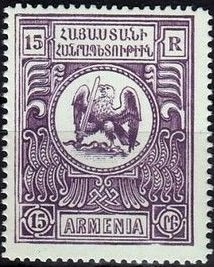Stamp: Country crest, eagle (Armenia 1920)
Country crest, eagle (Armenia 1920)
01 November (Armenia ) within release Local Motifs goes into circulation Stamp Country crest, eagle face value 15 Armenian ruble
| Stamp Country crest, eagle in catalogues | |
|---|---|
| Michel: | Mi: AM Ie |
| Yvert et Tellier: | Yt: AM 96A |
Stamp is square format.
Not issued for postal use, though some were used fiscallyAlso in the issue Local Motifs:
- Stamp - Mount Ararat face value 25;
- Stamp - Mount Ararat face value 50;
- Stamp - Country crest, eagle face value 1;
- Stamp - Spinner face value 70;
- Stamp - Country crest, eagle face value 1;
- Stamp - Country crest, eagle face value 10;
- Stamp - Country crest, eagle face value 15;
- Stamp - Mount Ararat face value 100;
- Stamp - Country crest, eagle face value 3;
- Stamp - Spinner face value 40;
- Stamp - Mount Ararat face value 50;
Stamp Country crest, eagle it reflects the thematic directions:
A coat of arms is an heraldic visual design on an escutcheon (i.e. shield), surcoat, or tabard. The coat of arms on an escutcheon forms the central element of the full heraldic achievement which in its whole consists of shield, supporters, crest, and motto. A coat of arms is traditionally unique to an individual person, family (except in the United Kingdom), state, organisation or corporation.
A symbol is a mark, sign, or word that indicates, signifies, or is understood as representing an idea, object, or relationship. Symbols allow people to go beyond what is known or seen by creating linkages between otherwise very different concepts and experiences. All communication (and data processing) is achieved through the use of symbols. Symbols take the form of words, sounds, gestures, ideas, or visual images and are used to convey other ideas and beliefs. For example, a red octagon is a common symbol for "STOP"; on maps, blue lines often represent rivers; and a red rose often symbolizes love and compassion. Numerals are symbols for numbers; letters of an alphabet may be symbols for certain phonemes; and personal names are symbols representing individuals.


